|
ROUTING: Machining Plastics: Optimizing Cutting Tool Productivity
Use of the correct
tool design and
material can turn
production processes
into profits.
Productivity — it’s the
name of the game.
Because of this, routing
has become the preferred
method of material removal with
practically all plastics. But to
achieve productivity, two things
must occur: the process must be
performed quickly and efficiently,
and the finish must be acceptable.
To achieve quality production, factors such as the
type of plastic being cut, cutting tool materials and
design, tool wear, fixturing and colleting need to be considered.
Cutting Tool Materials
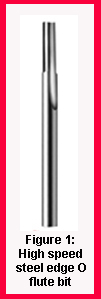
Three groups of cutting tool materials will be considered
for this analysis: high-speed
steel, carbide and diamond.
High-speed steel (HSS) has
been a low-cost, yet highly productive
tool material for cutting
both rigid plastics and
flexible plastics. It is particularly
well suited for hand-held
air or electric routers because
of the shank strength and
resistance to breakage.
Typically, HSS’s tool life is
not as long as carbide, particularly
in cutting Group R materials.
However, there are several
factors that can work in
HSS’s favor if the setup is difficult
to fixture and
the operating environment
is harsh.
(Figure 1)
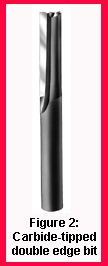 It is worth noting that HSS will not
perform on fiber-reinforced materials.
It is worth noting that HSS will not
perform on fiber-reinforced materials.
Carbide, on the other hand, is a
much more dense and harder cutting
tool material than HSS and must be
used with Group F materials. Carbide-tipped
tools — where carbide is
brazed to tool steel at the cutting
area — are also used to cut Group R
materials. Solid carbide tools —
where the tool is ground from a single
piece of carbide— can
be used to cut all groups
effectively. (Figure 2)
The downside of carbide
is that it is more
 expensive than HSS;
solid carbide bits are
roughly three times
more expensive than
HSS, and carbide-tipped
is roughly twice the price. However, the trade-off of
when to use HSS or carbide with Group R is one of
tool life and feed rates.
expensive than HSS;
solid carbide bits are
roughly three times
more expensive than
HSS, and carbide-tipped
is roughly twice the price. However, the trade-off of
when to use HSS or carbide with Group R is one of
tool life and feed rates.
When machining Group X, the decision between
carbide and HSS also becomes one of
price/performance and whether CNC
or hand-held machines are used.
Diamond tooling is worth consideration
when carbide’s tool life is not
acceptable. This is typically the case with more
exotic formulations of Group F. (Figure 3)
Tool Design
There is a theory that states, “If a cutting tool is
tough enough to cut steel or wood composites,
certainly it will cut plastics.”
Wrong. This fallacy is perhaps the single
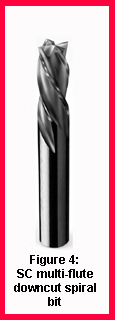 biggest
reason there are so many routers cutting plastic
materials today at less than 50 percent potential
productivity. Each plastic category, as wellas
many specific sub-categories, demand different
tool geometry for optimum router performance
and productivity.
biggest
reason there are so many routers cutting plastic
materials today at less than 50 percent potential
productivity. Each plastic category, as wellas
many specific sub-categories, demand different
tool geometry for optimum router performance
and productivity.
The design of the flute and the included angle of
the cutting edge are what differentiates a
plastic
router bit from a generic cutting tool. Plastics
have a unique characteristic in that chips have the
ability to reweld or stick themselves back on to the piece
part or cutting tool once cut. Tool geometry must be
designed to exit the chips away from the cut, not only to
resolve this problem, but to protect the finish.
Multi-flute solid carbide spiral tools are often preferred
for machining fiber-reinforced materials if a CNC router is
being used. If hand routers are used, the least-cost alternative
is a carbide-tipped tool with plastic geometry.
(Figure 4)
Rigid plastics are most often
cut with straight flute solid carbide
or high-speed tools with Z
flute plastic geometry. Carbide-tipped tools are
also used where cost effective. Tipped tools, however,
are limited in their
geometry when compared
with HSS or solid
carbide.
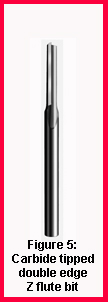
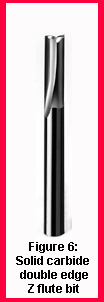
 Acrylics can be
cut very effectively with
a new concept in plastic
router tooling called
three-flute finishing
tools. (Figures 5-7)
Acrylics can be
cut very effectively with
a new concept in plastic
router tooling called
three-flute finishing
tools. (Figures 5-7)
Flexible plastics are
often most productively
cut with single-edge O
flute tools made from HSS or
solid carbide. These flutes may
be straight, shear or with a very
slow helix.
Tool Wear
Heat is the enemy of tool life.
Preventing the tool from becoming
hot will lead to longer life.
The first step in accomplishing
this is to match the proper tool
material to the type of plastic to be routed. The second is to select a cutting tool with the
proper plastic geometry for the material. It is essential
that this tool has a sharp edge to reduce heat. As the tool
edge dulls, it will slow down in the cut and the finish will
degrade.
The third principle is to take big chips — get the heat
out with the chip. This is accomplished by increasing the
feed rate and/or lowering the spindle speed until the finish
is no longer acceptable. Then, slow the feed rate
and/or lower the spindle rpm until the finish is acceptable
again. Do not dwell in the cut. Always feed the tool when
it is in contact with the plastic being cut.
Slow moving tools recut the same surface and further
cut the chips as they exit. Both generate heat. And each
time the tool impacts against the material, it has one less
revolution in its life.
Other tool life considerations are the rigidity of the
router, the rigidity of the setup and fixturing. Material
that moves when it is cut, for whatever reason, will cause
premature tool failure. Rubbing will cause both vibration
and heat. Stacking thin materials also makes an investment
in good fixturing pay off, provided the volume is
available.
Colleting
Many users select tools without regard to the importance
of adequately holding them in the collet. Both CNC
and air routers need 80 percent of the collet to be filled,
on the average. Over time they can lose elasticity
and harden, which in turn leads to runout, and in time,
uneven cutting action and poor finish.
Equally as important as changing the collet is cleaning
it with a wire brush, each and every time a tool is
changed. Chips, chemicals and resins, all made fluid by
heat, can migrate up the slits in the collet and deposit
themselves wherever they find an opening. If not
removed at each tool change, these deposits will continue
to build up, resulting in runout and tool failure. The
key clue is this: If brown marks on the shank of the tool
become visible at the mouth of the collet — problems are
about to begin.
CNC routing has made possible new advances in tool
life. Feed rates, multi-axis cutting action, spindle balance,
rigidity and horsepower all have been improved. However,
the right tool must be in the spindle to achieve design productivity.
Plastic Materials:
Know What You Are Cutting There are as many plastic materials as there are router bit designs. Materials can be grouped by class, with similar machining characteristics. |
- GROUP F:
The fiber-reinforced plastics. This group of materials has been machined in many ways, with varying degrees of success. The strength of the fibers and the thickness of the material often dictate whether this material is cut with a conventional fluted bit or ground with a rotating burr. Most conventional applications of fiber-reinforced materials are readily machined with either hand-held pneumatic or CNC fixed routers. Aircraft-type composites materials are much more difficult to machine with any degree of productivity.
- GROUP R:
Plastics of a rigid or brittle mature due to their
substance or cure time and process. Rigid materials can be difficult
to cut in a highly productive manner because of the cutting
environment. In most instances, however, productivity can
be achieved with the right setup, feed rate and cutting tool.
Rigid materials are best machined in a CNC environment.
-
GROUP X:
Plastic materials of a more flexible nature that
are thick enough to be machined with a rotary tool. They present
many potential problems for rigid fixturing, as well as cutting
tool geometry, when trying to achieve high productivity.
Each batch of material can affect cutting tool performance
because of different formulations, processing or coolants –
even different colors will affect material cutting characteristics.
|
For more information, click on the author biography at the top of this page.
| Back To Top |
|